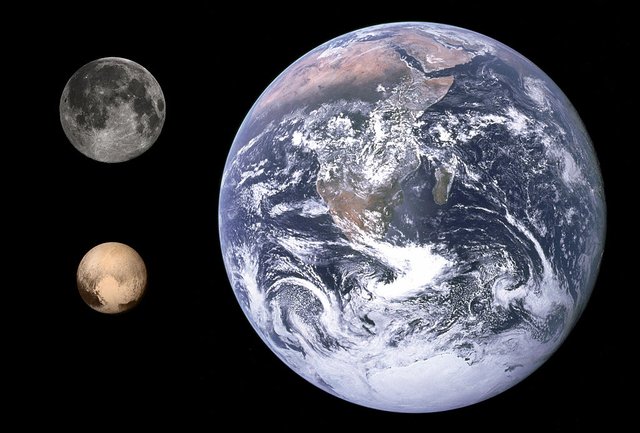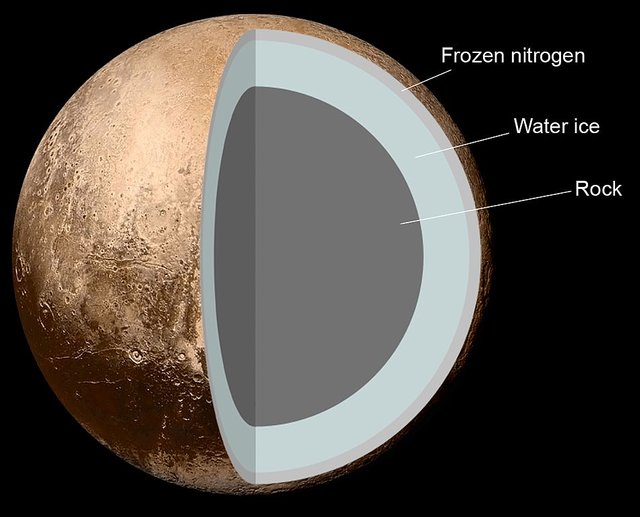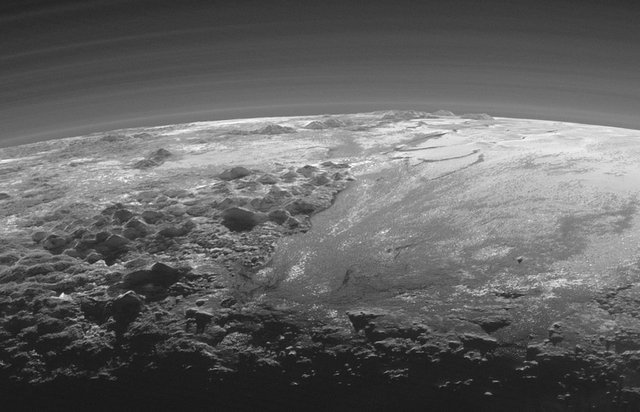Pluto - dwarf planet in the Kuiper belt
I will describe you the last (not official) planet of our Solar System.

By NASA / Johns Hopkins University Applied Physics Laboratory / Southwest Research Institute link [Public domain]
Pluto is a strange world. It is small, moves in an elongated, very distant orbit. He certainly doesn't belong to gas giants. However, it also doesn't fit into terrestrial planets. From its discovery to 2006, Pluto was officially recognized as the ninth planet of the Solar System. However, on August 24, 2006, the International Astronomical Union deprived Pluto of planet status. This small, distant world is circling in the dark ends of our solar system. For a lap of the Sun, from which it is 4.5 billion km away, it needs as many as 248 years!

Earth: NASA, Moon: Gregory H. Revera, Pluto: NASA/JHUAPL/SWRI link [Public domain]
Pluto, like Uranus, is rolling through its orbit around the Sun. The diameter of the Sun seen from Pluto is about 1 arc minute and has a magnitude of about -19 magnitude. This means that in the sky of Pluto, the Sun is a small dot with an amazing brightness, looks like an asterisk, and illuminates the planet and casts shadows of objects. However, it doesn't give heat. The temperature on Pluto ranges from - 230 to -210 degrees Celsius. We knew very little about the planet until the New Horizons mission, which in 2015 discovered Pluto again, giving us a completely new look at this distant world.

By NASA / Johns Hopkins University Applied Physics Laboratory / Southwest Research Institute link [Public domain]
Pluto's moon - Charon is only 2 times smaller than the planet, so the layout of these bodies is treated as a double dwarf planet. However, both these worlds are tiny compared to our Earth's Moon. The extraordinary features of Pluto make it perhaps from the Kuiper belt outside our Solar System. The dwarf planet Pluto is mainly made of ice. It has a nucleus of rock, and perhaps iron in the central part. Pluto has an atmosphere, but it is very thin. You can see it in the last photo of the article.

By NASA/Johns Hopkins University Applied Physics Laboratory/Southwest Research Institute link [Public domain]
Knowledge about Pluto wasn't very large due to its great distance from Earth. The New Horizons mission began in 2006. After more than 9 years, it reached the ends of the Solar System. At the end, a photo that really captivated me. Pluto's surface with a visible, delicate atmosphere. Photo taken by this probe on July 14, 2015. The farthest object that has been photographed. Beautiful Mountains on Pluto, right? For me, this view is really amazing!

This post has been voted on by the SteemSTEM curation team and voting trail in collaboration with @curie.
If you appreciate the work we are doing then consider voting both projects for witness by selecting stem.witness and curie!
For additional information please join us on the SteemSTEM discord and to get to know the rest of the community!
I remember Pluto being deprived of his planet status because of Charon. I was a PhD student at that time and I remember having discussed this with others in the institute. However, I would love to say that the last planet may be Planet IX. Let's be provocative :D
Lets call it a planet want-a-be :-)